A Systematic Review of Modeling and Simulation for Precision Diamond Wire Sawing of Monocrystalline Silicon
Abstract
:1. Introduction
1.1. Applications of Monocrystalline Silicon in PV Modules
1.2. Methodology
1.3. Review Structure
2. Mathematical Analytical Model
2.1. Principles of MAM
2.2. Diamond Wire Sawing by MAM
2.3. Summary of MAM
3. Molecular Dynamics Model
3.1. Principles of MD
3.1.1. Fundamental Principle
3.1.2. Potential Function
3.1.3. Boundary Conditions
3.2. Diamond Wire Sawing by MD
3.3. Summary of MD Model
4. Finite Element Method Model
4.1. Principles of FEM
4.2. Diamond Wire Sawing by FEM
4.3. Summary of FEM Model
5. Discussion
5.1. Similarity
5.2. Individuality
5.3. Complementarity
6. Outlook
- (1)
- MAMs are poised to continue playing a crucial role in optimizing machining parameters and predicting process effects. By employing theoretical analysis and mathematical formulations, MAM can forecast temperature and stress distributions, optimize cutting parameters, reduce material damage, and enhance surface quality. In the future, MAM is expected to facilitate advanced process monitoring, feedback control, and cross-scale research in DWS of monocrystalline silicon, leading to significant improvements in cutting efficiency, quality, and stability. This advancement is likely to markedly enhance the technology for sawing monocrystalline silicon.
- (2)
- The continuous advancements in computational power will facilitate the development of more detailed and accurate FEM models. These enhanced models will have the capability to capture intricate geometries and material behaviors, leading to a more realistic representation of monocrystalline silicon processing. FEM can further progress by integrating microstructure evolution across various processing stages. This extension allows for the prediction of imperfections, the evolution of grains, and various alterations at the microstructural level, all of which significantly influence material properties.
- (3)
- In the future, integrating MD, FEM, and MAM in monocrystalline silicon processing will significantly enhance both understanding and optimization of the manufacturing process. MD models reveal microscopic phenomena such as atomic interactions, which can refine FEM models for improved macroscopic simulations. This leads to better machining strategies, temperature control, crystal growth rates, and management of related factors. Meanwhile, MAM provides quantitative optimization and theoretical support, facilitating precise process control and efficient production strategies, thereby advancing the precision and efficiency of silicon processing technology.
- (4)
- Artificial Intelligence (AI) will play an important role in the study of DWS monocrystalline silicon through deep learning and optimization algorithms. AI can combine MD, FEM, and MAM to automatically analyze and optimize complex data from the cutting process. By learning from large amounts of experimental data, AI can reveal patterns of material behavior at the micro to macro level and automatically adjust model parameters to improve prediction accuracy.
Author Contributions
Funding
Institutional Review Board Statement
Informed Consent Statement
Data Availability Statement
Conflicts of Interest
References
- Deng, R.; Chang, N.L.; Ouyang, Z.; Chong, C.M. A Techno-Economic Review of Silicon Photovoltaic Module Recycling. Renew. Sustain. Energy Rev. 2019, 109, 532–550. [Google Scholar] [CrossRef]
- Ming, W.; Chen, Z.; Du, J.; Zhang, Z.; Zhang, G.; He, W.; Ma, J.; Shen, F. A Comprehensive Review of Theory and Technology of Glass Molding Process. Int. J. Adv. Manuf. Technol. 2020, 107, 2671–2706. [Google Scholar] [CrossRef]
- Damage-Free Machining of Monocrystalline Silicon Carbide. CIRP Ann. 2013, 62, 55–58. [CrossRef]
- Negi, S.; Bhandari, R. Silicon Isotropic and Anisotropic Etching for MEMS Applications. Microsyst. Technol. 2013, 19, 203–210. [Google Scholar] [CrossRef]
- Okil, M.; Salem, M.S.; Abdolkader, T.M.; Shaker, A. From Crystalline to Low-Cost Silicon-Based Solar Cells: A Review. Silicon 2022, 14, 1895–1911. [Google Scholar] [CrossRef]
- Zhang, G.; Guo, J.; Ming, W.; Huang, Y.; Shao, X.; Zhang, Z. Study of the Machining Process of Nano-Electrical Discharge Machining Based on Combined Atomistic-Continuum Modeling Method. Appl. Surf. Sci. 2014, 290, 359–367. [Google Scholar] [CrossRef]
- Mercaldo, L.V.; Delli Veneri, P. Silicon Solar Cells: Materials, Technologies, Architectures. In Solar Cells and Light Management; Elsevier: Amsterdam, The Netherlands, 2020; pp. 35–57. ISBN 978-0-08-102762-2. [Google Scholar]
- Fath, P.; Keller, S.; Winter, P.; Jooss, W.; Herbst, W. Status and Perspective of Crystalline Silicon Solar Cell Production. In Proceedings of the 2009 34th IEEE Photovoltaic Specialists Conference (PVSC), Philadelphia, PA, USA, 7–12 June 2009; pp. 002471–002476. [Google Scholar]
- Chen, J.; Li, X.; Jia, R.; Tang, Y.; Zhang, D.; Guo, C.; Zhu, H.; Gao, Z. Sulfonate Groups Assisted Texturing for Efficient Monocrystalline Silicon Solar Cells. Sol. Energy Mater. Sol. Cells 2023, 254, 112250. [Google Scholar] [CrossRef]
- Xu, M.; Xie, P.; Xie, B.-C. Study of China’s Optimal Solar Photovoltaic Power Development Path to 2050. Resour. Policy 2020, 65, 101541. [Google Scholar] [CrossRef]
- Tao, M.; Fthenakis, V.; Ebin, B.; Steenari, B.; Butler, E.; Sinha, P.; Corkish, R.; Wambach, K.; Simon, E.S. Major Challenges and Opportunities in Silicon Solar Module Recycling. Prog. Photovolt. Res. Appl. 2020, 28, 1077–1088. [Google Scholar] [CrossRef]
- Wang, X.; Tian, X.; Chen, X.; Ren, L.; Geng, C. A Review of End-of-Life Crystalline Silicon Solar Photovoltaic Panel Recycling Technology. Sol. Energy Mater. Sol. Cells 2022, 248, 111976. [Google Scholar] [CrossRef]
- Li, X.; Li, P.; Wu, Z.; Luo, D.; Yu, H.-Y.; Lu, Z.-H. Review and Perspective of Materials for Flexible Solar Cells. Mater. Rep. Energy 2021, 1, 100001. [Google Scholar] [CrossRef]
- Geretschläger, K.J.; Wallner, G.M.; Fischer, J. Structure and Basic Properties of Photovoltaic Module Backsheet Films. Sol. Energy Mater. Sol. Cells 2016, 144, 451–456. [Google Scholar] [CrossRef]
- Buerhop-Lutz, C.; Stroyuk, O.; Pickel, T.; Winkler, T.; Hauch, J.; Peters, I.M. PV Modules and Their Backsheets—A Case Study of a Multi-MW PV Power Station. Sol. Energy Mater. Sol. Cells 2021, 231, 111295. [Google Scholar] [CrossRef]
- Klugmann-Radziemska, E.; Ostrowski, P. Chemical Treatment of Crystalline Silicon Solar Cells as a Method of Recovering Pure Silicon from Photovoltaic Modules. Renew. Energy 2010, 35, 1751–1759. [Google Scholar] [CrossRef]
- Wang, Y.; Huang, S.; Qian, Z.; Su, J.; Du, L. Modeling and Experimental Investigation of Monocrystalline Silicon Wafer Cut by Diamond Wire Saw. Eng. Fract. Mech. 2023, 278, 109029. [Google Scholar] [CrossRef]
- Bhagavat, S.; Kao, I. Theoretical Analysis on the Effects of Crystal Anisotropy on Wiresawing Process and Application to Wafer Slicing. Int. J. Mach. Tools Manuf. 2006, 46, 531–541. [Google Scholar] [CrossRef]
- Wang, J.; Zhang, X.; Fang, F. Molecular Dynamics Study on Nanometric Cutting of Ion Implanted Silicon. Comput. Mater. Sci. 2016, 117, 240–250. [Google Scholar] [CrossRef]
- Hardin, C.W.; Shih, A.J.; Lemaster, R.L. Diamond Wire Machining of Wood. For. Prod. J. 2004, 54, 51. [Google Scholar]
- Wu, H. Wire Sawing Technology: A State-of-the-Art Review. Precis. Eng. 2016, 43, 1–9. [Google Scholar] [CrossRef]
- Xiao, H.; Wang, H.; Yu, N.; Liang, R.; Tong, Z.; Chen, Z.; Wang, J. Evaluation of Fixed Abrasive Diamond Wire Sawing Induced Subsurface Damage of Solar Silicon Wafers. J. Mater. Process. Technol. 2019, 273, 116267. [Google Scholar] [CrossRef]
- Ming, W.; Cao, C.; Xie, Z.; Liu, X.; Xu, Y.; Jiang, Z.; Li, X.; Liu, K.; Guo, X.; Yuan, J.; et al. Green Manufacturing: A Comparative Study of Renewable Dielectrics in the EDM Process. J. Braz. Soc. Mech. Sci. Eng. 2022, 44, 580. [Google Scholar] [CrossRef]
- Yin, Y.; Gao, Y.; Wang, L.; Zhang, L.; Pu, T. Analysis of Crack-Free Surface Generation of Photovoltaic Polysilicon Wafer Cut by Diamond Wire Saw. Sol. Energy 2021, 216, 245–258. [Google Scholar] [CrossRef]
- Liu, H.; Xie, W.; Sun, Y.; Zhu, X.; Wang, M. Investigations on Brittle-Ductile Cutting Transition and Crack Formation in Diamond Cutting of Mono-Crystalline Silicon. Int. J. Adv. Manuf. Technol. 2018, 95, 317–326. [Google Scholar] [CrossRef]
- Li, A.; Hu, S.; Zhou, Y.; Wang, H.; Zhang, Z.; Ming, W. Recent Advances in Precision Diamond Wire Sawing Monocrystalline Silicon. Micromachines 2023, 14, 1512. [Google Scholar] [CrossRef]
- Li, H.N.; Yu, T.B.; Zhu, L.D.; Wang, W.S. Analytical Modeling of Grinding-Induced Subsurface Damage in Monocrystalline Silicon. Mater. Des. 2017, 130, 250–262. [Google Scholar] [CrossRef]
- Huo, D.; Lin, C.; Choong, Z.J.; Pancholi, K.; Degenaar, P. Surface and Subsurface Characterisation in Micro-Milling of Monocrystalline Silicon. Int. J. Adv. Manuf. Technol. 2015, 81, 1319–1331. [Google Scholar] [CrossRef]
- Ming, W.; Guo, X.; Zhang, G.; Hu, S.; Liu, Z.; Xie, Z.; Zhang, S.; Duan, L. Optimization of Process Parameters and Performance for Machining Inconel 718 in Renewable Dielectrics. Alex. Eng. J. 2023, 79, 164–179. [Google Scholar] [CrossRef]
- Goel, S.; Luo, X.; Reuben, R.L. Wear Mechanism of Diamond Tools against Single Crystal Silicon in Single Point Diamond Turning Process. Tribol. Int. 2013, 57, 272–281. [Google Scholar] [CrossRef]
- Zhao, P.; Zhao, B.; Pan, J.; Wu, J. Superimpose Mechanism of Surface Generation Process in Grinding of Monocrystalline Silicon Using Molecular Dynamics Simulation. Mater. Sci. Semicond. Process. 2022, 147, 106684. [Google Scholar] [CrossRef]
- Novak, E. Mathematical Modeling for Theory-Oriented Research in Educational Technology. Educ. Tech. Res. Dev. 2022, 70, 149–167. [Google Scholar] [CrossRef]
- Dundar, S.; Gokkurt, B.; Soylu, Y. Mathematical Modelling at a Glance: A Theoretical Study. Procedia-Soc. Behav. Sci. 2012, 46, 3465–3470. [Google Scholar] [CrossRef]
- Li, H.N.; Yu, T.B.; Da Zhu, L.; Wang, W.S. Analytical Modeling of Ground Surface Topography in Monocrystalline Silicon Grinding Considering the Ductile-Regime Effect. Arch. Civ. Mech. Eng. 2017, 17, 880–893. [Google Scholar] [CrossRef]
- Pawar, P.; Ballav, R.; Kumar, A. Machining processes of silicon carbide: A review. Rev. Adv. Mater. Sci. 2017, 51, 62–76. [Google Scholar]
- Wang, J.; Fang, F.; Zhang, X. An Experimental Study of Cutting Performance on Monocrystalline Germanium after Ion Implantation. Precis. Eng. 2015, 39, 220–223. [Google Scholar] [CrossRef]
- Hara, Y.; Ide, K.; Nishihara, T.; Yokogawa, R.; Nakamura, K.; Ohshita, Y.; Kawatsu, T.; Nagai, T.; Aoki, Y.; Kobayashi, H.; et al. Effect of Sawing Damage on Flexibility of Crystalline Silicon Wafers for Thin Flexible Silicon Solar Cells. Jpn. J. Appl. Phys. 2022, 62, 017001. [Google Scholar] [CrossRef]
- Li, H.N.; Yu, T.B.; Zhu, L.D.; Wang, W.S. Evaluation of Grinding-Induced Subsurface Damage in Optical Glass BK7. J. Mater. Process. Technol. 2016, 229, 785–794. [Google Scholar] [CrossRef]
- Li, J.; Fang, Q.; Zhang, L.; Liu, Y. Subsurface Damage Mechanism of High Speed Grinding Process in Single Crystal Silicon Revealed by Atomistic Simulations. Appl. Surf. Sci. 2015, 324, 464–474. [Google Scholar] [CrossRef]
- Goel, S.; Luo, X.; Agrawal, A.; Reuben, R.L. Diamond Machining of Silicon: A Review of Advances in Molecular Dynamics Simulation. Int. J. Mach. Tools Manuf. 2015, 88, 131–164. [Google Scholar] [CrossRef]
- Gogotsi, Y.; Zhou, G.; Ku, S.-S.; Cetinkunt, S. Raman Microspectroscopy Analysis of Pressure-Induced Metallization in Scratching of Silicon. Semicond. Sci. Technol. 2001, 16, 345. [Google Scholar] [CrossRef]
- Tang, F.; Zhang, L. Subsurface Nanocracking in Monocrystalline Si (001) Induced by Nanoscratching. Eng. Fract. Mech. 2014, 124–125, 262–271. [Google Scholar] [CrossRef]
- Yoshino, M.; Aoki, T.; Shirakashi, T.; Komanduri, R. Some Experiments on the Scratching of Silicon: In Situ Scratching inside an SEM and Scratching under High External Hydrostatic Pressures. Int. J. Mech. Sci. 2001, 43, 335–347. [Google Scholar] [CrossRef]
- Sun, J.; Qin, F.; Chen, P.; An, T. A Predictive Model of Grinding Force in Silicon Wafer Self-Rotating Grinding. Int. J. Mach. Tools Manuf. 2016, 109, 74–86. [Google Scholar] [CrossRef]
- Gu, W.; Yao, Z.; Li, H. Investigation of Grinding Modes in Horizontal Surface Grinding of Optical Glass BK7. J. Mater. Process. Technol. 2011, 211, 1629–1636. [Google Scholar] [CrossRef]
- Jing, X.; Maiti, S.; Subhash, G. A New Analytical Model for Estimation of Scratch-Induced Damage in Brittle Solids. J. Am. Ceram. Soc. 2007, 90, 885–892. [Google Scholar] [CrossRef]
- Tao, H.; Liu, Y.; Zhao, D.; Lu, X. The Material Removal and Surface Generation Mechanism in Ultra-Precision Grinding of Silicon Wafers. Int. J. Mech. Sci. 2022, 222, 107240. [Google Scholar] [CrossRef]
- Suzuki, T.; Nishino, Y.; Yan, J. Mechanisms of Material Removal and Subsurface Damage in Fixed-Abrasive Diamond Wire Slicing of Single-Crystalline Silicon. Precis. Eng. 2017, 50, 32–43. [Google Scholar] [CrossRef]
- Chung, C.; Nhat, L.V. Generation of Diamond Wire Sliced Wafer Surface Based on the Distribution of Diamond Grits. Int. J. Precis. Eng. Manuf. 2014, 15, 789–796. [Google Scholar] [CrossRef]
- Gao, Y.; Ge, P.; Zhang, L.; Bi, W. Material Removal and Surface Generation Mechanisms in Diamond Wire Sawing of Silicon Crystal. Mater. Sci. Semicond. Process. 2019, 103, 104642. [Google Scholar] [CrossRef]
- Yin, S.; Xiao, H.; Wu, H.; Wang, C.; Cheung, C.F. Image-Processing-Based Model for the Characterization of Surface Roughness and Subsurface Damage of Silicon Wafer in Diamond Wire Sawing. Precis. Eng. 2022, 77, 263–274. [Google Scholar] [CrossRef]
- Li, S.; Wang, Z.; Wu, Y. Relationship between Subsurface Damage and Surface Roughness of Optical Materials in Grinding and Lapping Processes. J. Mater. Process. Technol. 2008, 205, 34–41. [Google Scholar] [CrossRef]
- Evans, C.J.; Paul, E.; Dornfeld, D.; Lucca, D.A.; Byrne, G.; Tricard, M.; Klocke, F.; Dambon, O.; Mullany, B.A. Material Removal Mechanisms in Lapping and Polishing. CIRP Ann. 2003, 52, 611–633. [Google Scholar] [CrossRef]
- Xiao, H.; Yin, S.; Wang, H.; Liu, Y.; Wu, H.; Liang, R.; Cao, H. Models of Grinding-Induced Surface and Subsurface Damages in Fused Silica Considering Strain Rate and Micro Shape/Geometry of Abrasive. Ceram. Int. 2021, 47, 24924–24941. [Google Scholar] [CrossRef]
- Marshall, D.B.; Lawn, B.R.; Evans, A.G. Elastic/Plastic Indentation Damage in Ceramics: The Lateral Crack System. J. Am. Ceram. Soc. 1982, 65, 561–566. [Google Scholar] [CrossRef]
- Chen, Y.; Guo, X.; Zhang, G.; Cao, Y.; Shen, D.; Li, X.; Zhang, S.; Ming, W. Development of a Hybrid Intelligent Process Model for Micro-Electro Discharge Machining Using the TTM-MDS and Gaussian Process Regression. Micromachines 2022, 13, 845. [Google Scholar] [CrossRef]
- Dai, H.; Li, S.; Chen, G. Comparison of Subsurface Damages on Mono-Crystalline Silicon between Traditional Nanoscale Machining and Laser-Assisted Nanoscale Machining via Molecular Dynamics Simulation. Nucl. Instrum. Methods Phys. Res. Sect. B Beam Interact. Mater. At. 2018, 414, 61–67. [Google Scholar] [CrossRef]
- Badar, M.S.; Shamsi, S.; Ahmed, J.; Alam, M.d.A. Molecular Dynamics Simulations: Concept, Methods, and Applications. In Transdisciplinarity; Rezaei, N., Ed.; Integrated Science; Springer International Publishing: Cham, Switzerland, 2022; Volume 5, pp. 131–151. ISBN 978-3-030-94650-0. [Google Scholar]
- Huang, H.; Xu, Y.; Luo, G.; Xie, Z.; Ming, W. Molecular Dynamics Study of Laser Interaction with Nanoparticles in Liquids and Its Potential Application. Nanomaterials 2022, 12, 1524. [Google Scholar] [CrossRef] [PubMed]
- Dai, H.; Chen, G.; Zhou, C.; Fang, Q.; Fei, X. A Numerical Study of Ultraprecision Machining of Monocrystalline Silicon with Laser Nano-Structured Diamond Tools by Atomistic Simulation. Appl. Surf. Sci. 2017, 393, 405–416. [Google Scholar] [CrossRef]
- Papanikolaou, M.; Salonitis, K. Grain Size Effects on Nanocutting Behaviour Modelling Based on Molecular Dynamics Simulations. Appl. Surf. Sci. 2021, 540, 148291. [Google Scholar] [CrossRef]
- Liu, B.; Yang, H.; Xu, Z.; Wang, D.; Ji, H. Molecular Dynamics Simulation of Nanomachining Mechanism between Monocrystalline and Polycrystalline Silicon Carbide. Adv. Theory Simul. 2021, 4, 2100113. [Google Scholar] [CrossRef]
- Dai, H.; Chen, G.; Fang, Q.; Yin, J. The Effect of Tool Geometry on Subsurface Damage and Material Removal in Nanometric Cutting Single-Crystal Silicon by a Molecular Dynamics Simulation. Appl. Phys. A 2016, 122, 804. [Google Scholar] [CrossRef]
- Huang, H.; Yang, W.; Ming, W.; Zhang, G.; Xu, Y.; Zhang, Z. Mechanism of Springback Behavior in Ultra-Thin Glass Molding Process: A Molecular Dynamics Study. J. Non-Cryst. Solids 2022, 596, 121841. [Google Scholar] [CrossRef]
- Xu, J.; Chen, X.; Yang, G.; Niu, X.; Chang, F.; Lacidogna, G. Review of Research on Micromechanical Properties of Cement-Based Materials Based on Molecular Dynamics Simulation. Constr. Build. Mater. 2021, 312, 125389. [Google Scholar] [CrossRef]
- Guo, J.; Zhang, G.; Huang, Y.; Ming, W.; Liu, M.; Huang, H. Investigation of the Removing Process of Cathode Material in Micro-EDM Using an Atomistic-Continuum Model. Appl. Surf. Sci. 2014, 315, 323–336. [Google Scholar] [CrossRef]
- Meller, J. Molecular Dynamics. In eLS; John Wiley & Sons, Ltd.: New York, NY, USA, 2001; ISBN 978-0-470-01590-2. [Google Scholar]
- Liu, Z. Moleclar Dynaics Simulation Study of Diamond Wire Sawing Mechanism in Monocrystalline Silicon. Ph.D. Thesis, Nanchang University, Nanchang, China, 2022. [Google Scholar]
- Tian, Z.; Xu, X.; Jiang, F.; Lu, J.; Luo, Q.; Lin, J. Study on Nanomechanical Properties of 4H-SiC and 6H-SiC by Molecular Dynamics Simulations. Ceram. Int. 2019, 45, 21998–22006. [Google Scholar] [CrossRef]
- Wang, P.; Zhou, D.; Zhao, H.; Lin, Y.; Nie, A.; Wang, H. Dislocation-Mediated Brittle-Ductile Transition of Diamond under High Pressure. Diam. Relat. Mater. 2023, 138, 110198. [Google Scholar] [CrossRef]
- Ameli Kalkhoran, S.N.; Vahdati, M.; Yan, J. Molecular Dynamics Investigation of Nanometric Cutting of Single-Crystal Silicon Using a Blunt Tool. JOM 2019, 71, 4296–4304. [Google Scholar] [CrossRef]
- Dai, H.; Zhang, F.; Zhou, Y. Numerical Study of Three-Body Diamond Abrasive Polishing Single Crystal Si under Graphene Lubrication by Molecular Dynamics Simulation. Comput. Mater. Sci. 2020, 171, 109214. [Google Scholar] [CrossRef]
- Zhao, H.; Zhang, P.; Shi, C.; Liu, C.; Han, L.; Cheng, H.; Ren, L. Molecular Dynamics Simulation of the Crystal Orientation and Temperature Influences in the Hardness on Monocrystalline Silicon. J. Nanomater. 2014, 2014, 365642. [Google Scholar] [CrossRef]
- Liu, Z.; Lin, B.; Liang, X.; Du, A. Study on the Effect of Laser-Assisted Machining on Tool Wear Based on Molecular Dynamics Simulation. Diam. Relat. Mater. 2020, 109, 108022. [Google Scholar] [CrossRef]
- Dai, H.; Chen, J.; Liu, G. A Numerical Study on Subsurface Quality and Material Removal during Ultrasonic Vibration Assisted Cutting of Monocrystalline Silicon by Molecular Dynamics Simulation. Mater. Res. Express 2019, 6, 065908. [Google Scholar] [CrossRef]
- Dai, H.; Chen, G.; Li, S.; Fang, Q.; Hu, B. Influence of Laser Nanostructured Diamond Tools on the Cutting Behavior of Silicon by Molecular Dynamics Simulation. RSC Adv. 2017, 7, 15596–15612. [Google Scholar] [CrossRef]
- Liu, C.; To, S.; Sheng, X.; Xu, J. Molecular Dynamics Simulation on Crystal Defects of Single-Crystal Silicon during Elliptical Vibration Cutting. Int. J. Mech. Sci. 2023, 244, 108072. [Google Scholar] [CrossRef]
- Lippert, R.A.; Bowers, K.J.; Dror, R.O.; Eastwood, M.P.; Gregersen, B.A.; Klepeis, J.L.; Kolossvary, I.; Shaw, D.E. A Common, Avoidable Source of Error in Molecular Dynamics Integrators. J. Chem. Phys. 2007, 126, 046101. [Google Scholar] [CrossRef] [PubMed]
- Zhou, N.; Liu, B.; Zhang, C.; Li, K.; Zhou, L. Molecular Dynamics Study of Anisotropic Growth of Silicon. Chin. Phys. B 2016, 25, 078109. [Google Scholar] [CrossRef]
- Molecular Dynamics: The Art of Computer Simulation. Available online: https://catalyst.blogs.rice.edu/archives/23 (accessed on 22 July 2024).
- Davis, S.; Loyola, C.; González, F.; Peralta, J. Las Palmeras Molecular Dynamics: A Flexible and Modular Molecular Dynamics Code. Comput. Phys. Commun. 2010, 181, 2126–2139. [Google Scholar] [CrossRef]
- Wang, Z.; Xu, Y.; Liu, Y.; Liu, X.; Rui, Z. Molecular Dynamics-Based Simulation on Chemical Flooding Produced Emulsion Formation and Stabilization: A Critical Review. Arab. J. Sci. Eng. 2020, 45, 7161–7173. [Google Scholar] [CrossRef]
- Cai, M.B.; Li, X.P.; Rahman, M. Characteristics of “Dynamic Hard Particles” in Nanoscale Ductile Mode Cutting of Monocrystalline Silicon with Diamond Tools in Relation to Tool Groove Wear. Wear 2007, 263, 1459–1466. [Google Scholar] [CrossRef]
- Han, G. Analysis of Multi-Scale Molecular Dynamics Algorithms for Simulating Biomolecule. Ph.D. Thesis, Stony Brook University, Stony Brook, NY, USA, 2006. [Google Scholar]
- Li, X. On the Stability of Boundary Conditions for Molecular Dynamics. J. Comput. Appl. Math. 2009, 231, 493–505. [Google Scholar] [CrossRef]
- Lee, C.-S.; Chen, Y.-Y.; Yu, C.-H.; Hsu, Y.-C.; Chen, C.-S. Semi-Analytical Solution for the Generalized Absorbing Boundary Condition in Molecular Dynamics Simulations. Comput. Mech. 2017, 60, 23–37. [Google Scholar] [CrossRef]
- Reed, M.S.C.; Flurchick, K.M. Investigation of Artifacts Due to Periodic Boundary Conditions. Comput. Phys. Commun. 1996, 95, 39–46. [Google Scholar] [CrossRef]
- Barbhuiya, S.; Das, B.B. Molecular Dynamics Simulation in Concrete Research: A Systematic Review of Techniques, Models and Future Directions. J. Build. Eng. 2023, 76, 107267. [Google Scholar] [CrossRef]
- Cai, M.B.; Li, X.P.; Rahman, M. Study of the Temperature and Stress in Nanoscale Ductile Mode Cutting of Silicon Using Molecular Dynamics Simulation. J. Mater. Process. Technol. 2007, 192–193, 607–612. [Google Scholar] [CrossRef]
- Zhou, W.J.; Luan, H.B.; He, Y.L.; Sun, J.; Tao, W.Q. A Study on Boundary Force Model Used in Multiscale Simulations with Non-Periodic Boundary Condition. Microfluid. Nanofluid 2014, 16, 587–595. [Google Scholar] [CrossRef]
- Guan, P.; Li, J.Q.; Zhu, S.; Yu, T.B.; Wang, W.S. Advances in Simulation of Grinding Process. Appl. Mech. Mater. 2012, 121–126, 1879–1885. [Google Scholar] [CrossRef]
- Jackson, M.J.; Novakov, T.; da Silva, M.B.; Handy, R.; Robinson, G.; Whitfield, M.; Morrell, J.; Ahmed, W. Atomic Scale Machining of Medical Materials. In Surgical Tools and Medical Devices; Ahmed, W., Jackson, M.J., Eds.; Springer International Publishing: Cham, Switzerland, 2016; pp. 1–54. ISBN 978-3-319-33489-9. [Google Scholar]
- Zhang, Z.; Chen, P.; Qin, F. Molecular Dynamics Simulation on Subsurface Damage Layer during Nano Grinding Process of Silicon Wafer. In Proceedings of the 2017 18th International Conference on Electronic Packaging Technology (ICEPT), Harbin, China, 16–19 August 2017; pp. 487–490. [Google Scholar]
- Li, J.; Fang, Q.; Zhang, L.; Liu, Y. The Effect of Rough Surface on Nanoscale High Speed Grinding by a Molecular Dynamics Simulation. Comput. Mater. Sci. 2015, 98, 252–262. [Google Scholar] [CrossRef]
- Guo, X.; Li, Q.; Liu, T.; Zhai, C.; Kang, R.; Jin, Z. Molecular Dynamics Study on the Thickness of Damage Layer in Multiple Grinding of Monocrystalline Silicon. Mater. Sci. Semicond. Process. 2016, 51, 15–19. [Google Scholar] [CrossRef]
- Li, P.; Guo, X.; Yuan, S.; Li, M.; Kang, R.; Guo, D. Effects of Grinding Speeds on the Subsurface Damage of Single Crystal Silicon Based on Molecular Dynamics Simulations. Appl. Surf. Sci. 2021, 554, 149668. [Google Scholar] [CrossRef]
- Zhao, P.; Pan, J.; Zhao, B.; Wu, J. Molecular Dynamics Study of Crystal Orientation Effect on Surface Generation Mechanism of Single-Crystal Silicon during the Nano-Grinding Process. J. Manuf. Process. 2022, 74, 190–200. [Google Scholar] [CrossRef]
- Zhao, B.; Zhao, P.; Wu, J.; Pan, J.; Wu, J. Investigation on Surface Generation Mechansim of Single-Crystal Silicon in Grinding: Surface Crystal Orientation Effect. SSRN J. 2022, 34, 105125. [Google Scholar] [CrossRef]
- Wallburg, F.; Kuna, M.; Budnitzki, M.; Schoenfelder, S. Experimental and Numerical Analysis of Scratching Induced Damage during Diamond Wire Sawing of Silicon. Wear 2020, 454–455, 203328. [Google Scholar] [CrossRef]
- Niu, Y.; Zhao, D.; Wang, S.; Li, S.; Wang, Z.; Zhao, H. Investigations on Thermal Effects on Scratch Behavior of Monocrystalline Silicon via Molecular Dynamics Simulation. Mater. Today Commun. 2021, 26, 102042. [Google Scholar] [CrossRef]
- Tao, H.; Zeng, Q.; Liu, Y.; Zhao, D.; Lu, X. Influence of Anisotropy on Material Removal and Deformation Mechanism Based on Nanoscratch Tests of Monocrystal Silicon. Tribol. Int. 2023, 187, 108736. [Google Scholar] [CrossRef]
- Sabat, L.; Kundu, C.K. History of Finite Element Method: A Review. In Recent Developments in Sustainable Infrastructure; Springer: Singapore, 2021; pp. 395–404. [Google Scholar]
- Gu, X.; Wang, H.; Zhao, Q.; Xue, J.; Guo, B. Effect of Cutting Tool Geometries on the Ductile-Brittle Transition of Monocrystalline Sapphire. Int. J. Mech. Sci. 2018, 148, 565–577. [Google Scholar] [CrossRef]
- Mackerle, J. Finite-Element Analysis and Simulation of Machining: A Bibliography (1976–1996). J. Mater. Process. Technol. 1999, 86, 17–44. [Google Scholar] [CrossRef]
- Ming, W.; Sun, P.; Zhang, Z.; Qiu, W.; Du, J.; Li, X.; Zhang, Y.; Zhang, G.; Liu, K.; Wang, Y.; et al. A Systematic Review of Machine Learning Methods Applied to Fuel Cells in Performance Evaluation, Durability Prediction, and Application Monitoring. Int. J. Hydrog. Energy 2023, 48, 5197–5228. [Google Scholar] [CrossRef]
- Lauro, C.H.; Brandão, L.C.; Ribeiro Filho, S.L.M.; Valente, R.A.F.; Davim, J.P. Finite Element Method in Machining Processes: A Review. In Modern Manufacturing Engineering; Springer: Cham, Switzerland, 2015; pp. 65–97. [Google Scholar]
- Zhang, Z.; Ming, W.; Zhang, Y.; Yin, L.; Xue, T.; Yu, H.; Chen, Z.; Liao, D.; Zhang, G. Analyzing Sustainable Performance on High-Precision Molding Process of 3D Ultra-Thin Glass for Smart Phone. J. Clean. Prod. 2020, 255, 120196. [Google Scholar] [CrossRef]
- Zhou, W.; Su, H.; Dai, J.; Yu, T.; Zheng, Y. Numerical Investigation on the Influence of Cutting-Edge Radius and Grinding Wheel Speed on Chip Formation in SiC Grinding. Ceram. Int. 2018, 44, 21451–21460. [Google Scholar] [CrossRef]
- Ming, W.; Zhang, S.; Zhang, G.; Du, J.; Ma, J.; He, W.; Cao, C.; Liu, K. Progress in Modeling of Electrical Discharge Machining Process. Int. J. Heat. Mass. Transf. 2022, 187, 122563. [Google Scholar] [CrossRef]
- Kien, D.N.; Zhuang, X. Radial Basis Function Based Finite Element Method: Formulation and Applications. Eng. Anal. Bound. Elem. 2023, 152, 455–472. [Google Scholar] [CrossRef]
- Li, X.; Zhu, H.; Chen, Z.; Ming, W.; Cao, Y.; He, W.; Ma, J. Limit State Kriging Modeling for Reliability-Based Design Optimization through Classification Uncertainty Quantification. Reliab. Eng. Syst. Saf. 2022, 224, 108539. [Google Scholar] [CrossRef]
- Axelsson, O.; Barker, V.A. Finite Element Solution of Boundary Value Problems: Theory and Computation; Classics in applied mathematics; Society for Industrial and Applied Mathematics: Philadelphia, PA, USA, 2001; ISBN 978-0-89871-499-9. [Google Scholar]
- Ma, J.; Yuan, J.; Ming, W.; He, W.; Zhang, G.; Zhang, H.; Cao, Y.; Jiang, Z. Non-Traditional Processing of Carbon Nanotubes: A Review. Alex. Eng. J. 2022, 61, 597–617. [Google Scholar] [CrossRef]
- Huang, Y.; Ming, W.; Li, M.; Liu, Y.; Guo, J.; Li, J.; Shao, X.; Wang, S. Parameter Optimization of Nd:Yag Laser Scribing Process on Core Loss of Grain-Oriented Magnetic Silicon Steels. Int. J. Adv. Manuf. Technol. 2014, 70, 1–9. [Google Scholar] [CrossRef]
- Jagota, V.; Sethi, A.P.S.; Kumar, K. Finite Element Method: An Overview. Walailak J. Sci. Technol. (WJST) 2013, 10, 1–8. [Google Scholar]
- Ma, J.; Ming, W.; Du, J.; Huang, H.; He, W.; Cao, Y.; Li, X. Integrated Optimization Model in Wire Electric Discharge Machining Using Gaussian Process Regression and Wolf Pack Algorithm Approach While Machining SiCp/Al Composite. Adv. Mech. Eng. 2018, 10, 1687814018787407. [Google Scholar] [CrossRef]
- Konda, P.; Sa, T. Basic Principles of Finite Element Method and Its Applications in Orthodontics. J. Pharm. Biomed. Sci. 2012, 16, 1–8. [Google Scholar]
- Behrens, B.-A. Finite Element Analysis. In CIRP Encyclopedia of Production Engineering; Chatti, S., Laperrière, L., Reinhart, G., Tolio, T., Eds.; Springer: Berlin/Heidelberg, Germany, 2019; pp. 672–676. ISBN 978-3-662-53120-4. [Google Scholar]
- Ming, W.; Shen, F.; Zhang, Z.; Huang, H.; Du, J.; Wu, J. A Comparative Investigation on Magnetic Field–Assisted EDM of Magnetic and Non-Magnetic Materials. Int. J. Adv. Manuf. Technol. 2020, 109, 1103–1116. [Google Scholar] [CrossRef]
- Zhang, Q.; Fu, Y.; Su, H.; Zhao, Q.; To, S. Surface Damage Mechanism of Monocrystalline Silicon during Single Point Diamond Grinding. Wear 2018, 396–397, 48–55. [Google Scholar] [CrossRef]
- Walters, J.; Sunder, K.; Anspach, O.; Brooker, R.P.; Seigneur, H. Challenges Associated with Diamond Wire Sawing When Generating Reduced Thickness Mono-Crystalline Silicon Wafers. In Proceedings of the 2016 IEEE 43rd Photovoltaic Specialists Conference (PVSC), Portland, OR, USA, 5–10 June 2016; pp. 0724–0728. [Google Scholar]
- Kumar, A.; Kaminski, S.; Melkote, S.N.; Arcona, C. Effect of Wear of Diamond Wire on Surface Morphology, Roughness and Subsurface Damage of Silicon Wafers. Wear 2016, 364–365, 163–168. [Google Scholar] [CrossRef]
- Wang, Y.; Zhang, S.; Dong, G.; Su, J.; Qian, Z.; Zhou, J. Theoretical Study on Sawing Force of Ultrasonic Vibration Assisted Diamond Wire Sawing (UAWS) Based on Abrasives Wear. Wear 2022, 496–497, 204291. [Google Scholar] [CrossRef]
- Zhang, J.; Zhang, X.; Jen, T.-C.; Liu, J.; Yen, Y.-H. FEM Analysis on Damage Layer in Wire Saw Cutting Single Crystal Silicon. In Proceedings of the ASME 2010 International Mechanical Engineering Congress and Exposition, Vancouver, BC, Canada, 12–18 November 2010; pp. 899–903. [Google Scholar]
- Chen, Y.; Zhang, S.; Hu, S.; Zhao, Y.; Zhang, G.; Cao, Y.; Ming, W. Study of Heat Transfer Strategy of Metal Heating/Conduction Plates for Energy Efficiency of Large-Sized Automotive Glass Molding Process. Metals 2023, 13, 1218. [Google Scholar] [CrossRef]
- Wang, Y.; Song, L.-X.; Liu, J.-G.; Wang, R.; Zhao, B.-C. Investigation on the Sawing Temperature in Ultrasonic Vibration Assisted Diamond Wire Sawing Monocrystalline Silicon. Mater. Sci. Semicond. Process. 2021, 135, 106070. [Google Scholar] [CrossRef]
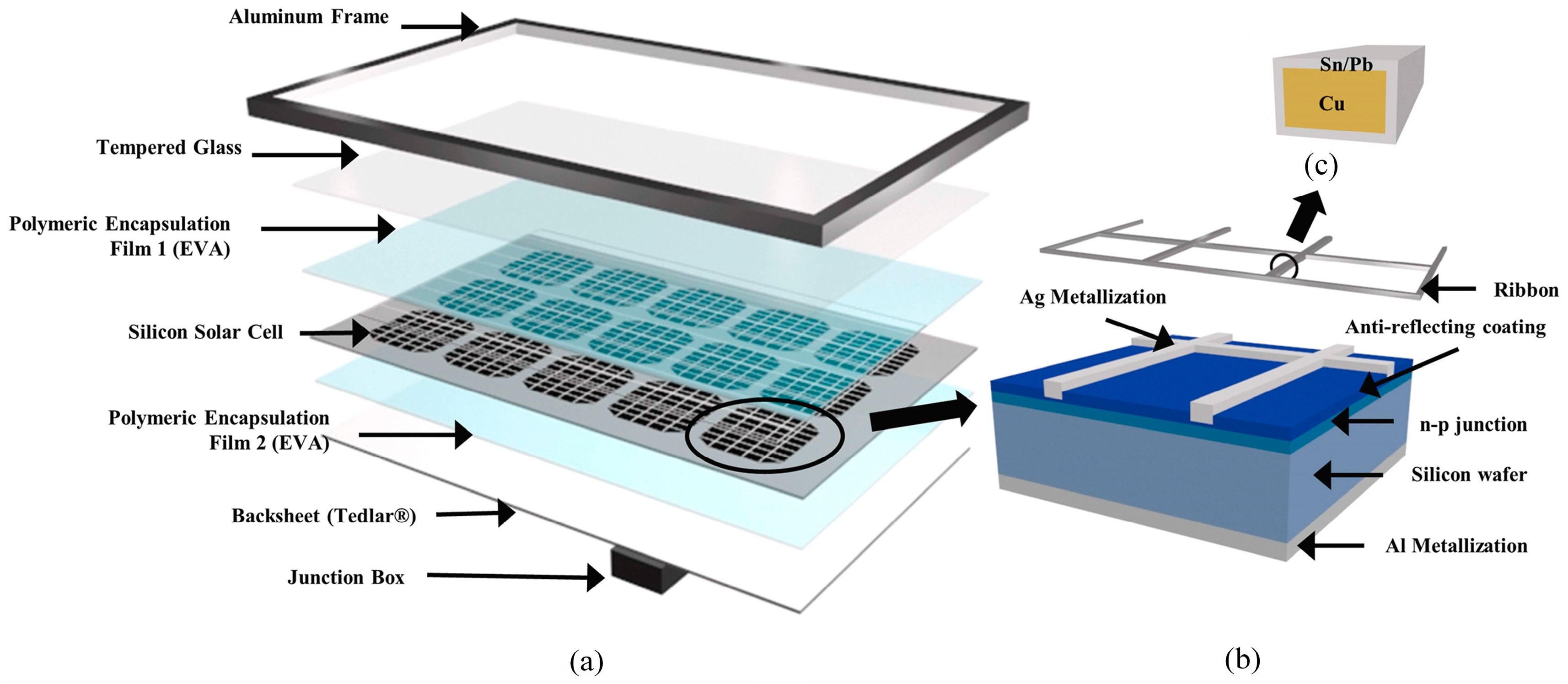


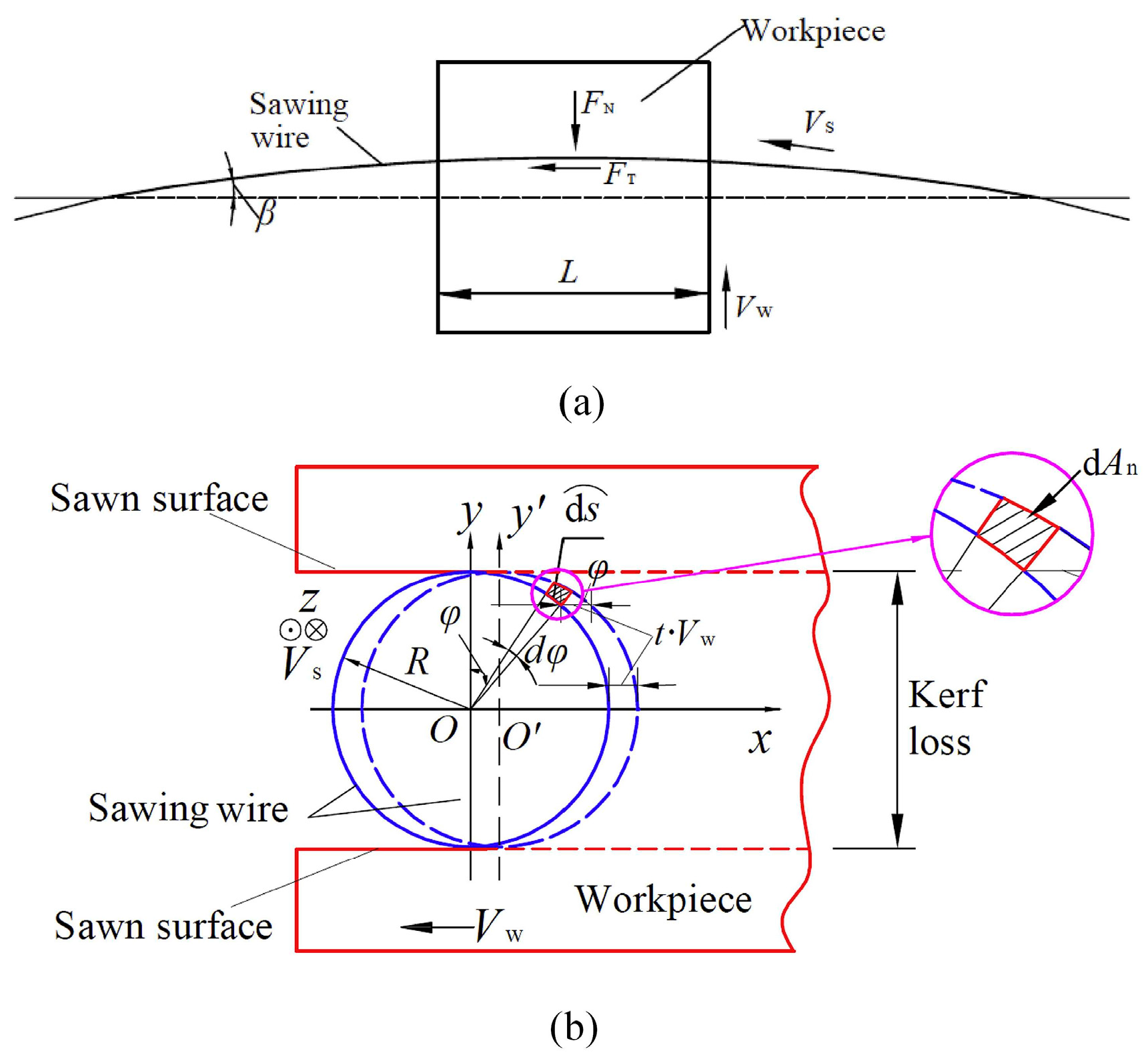
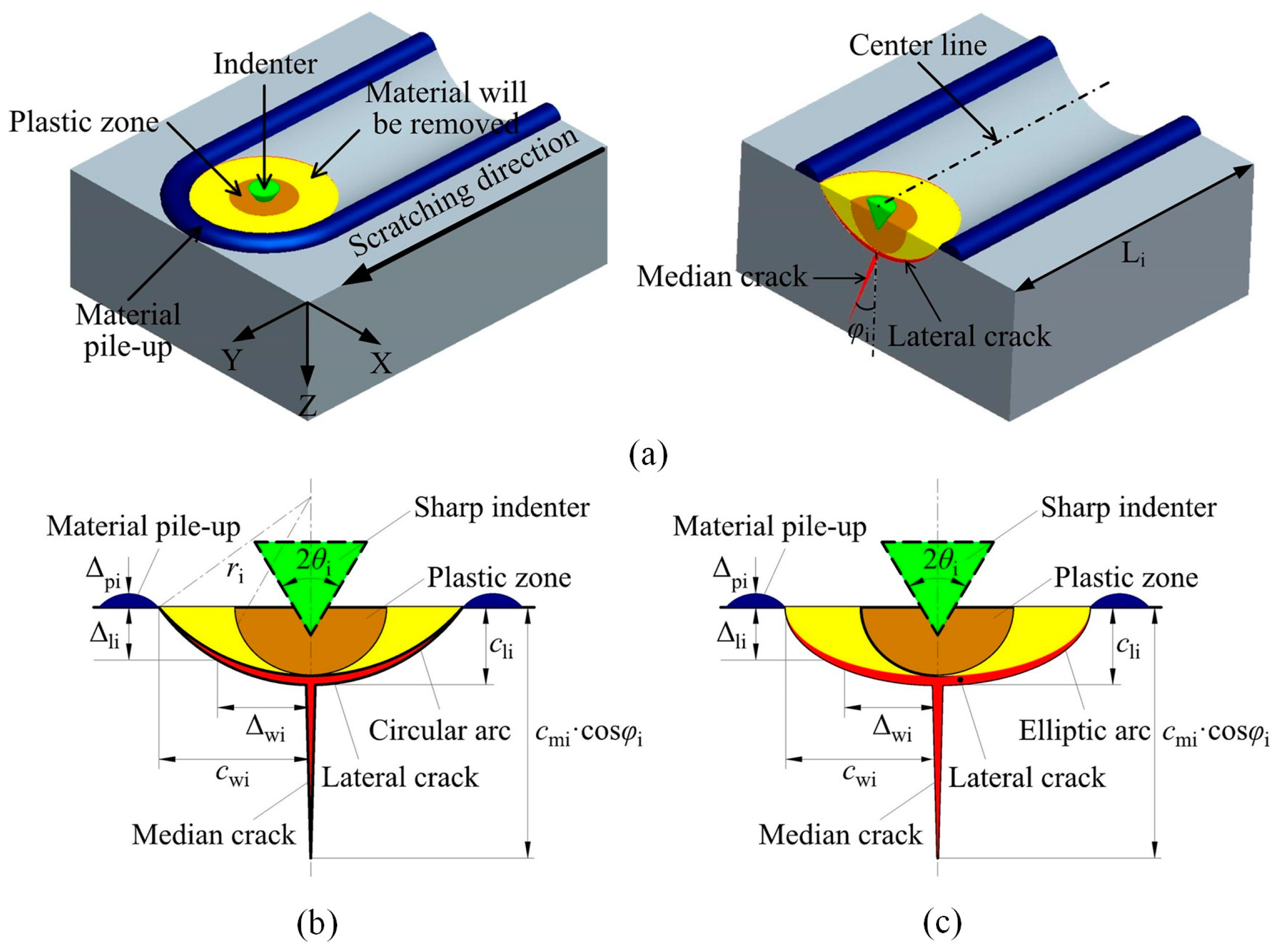
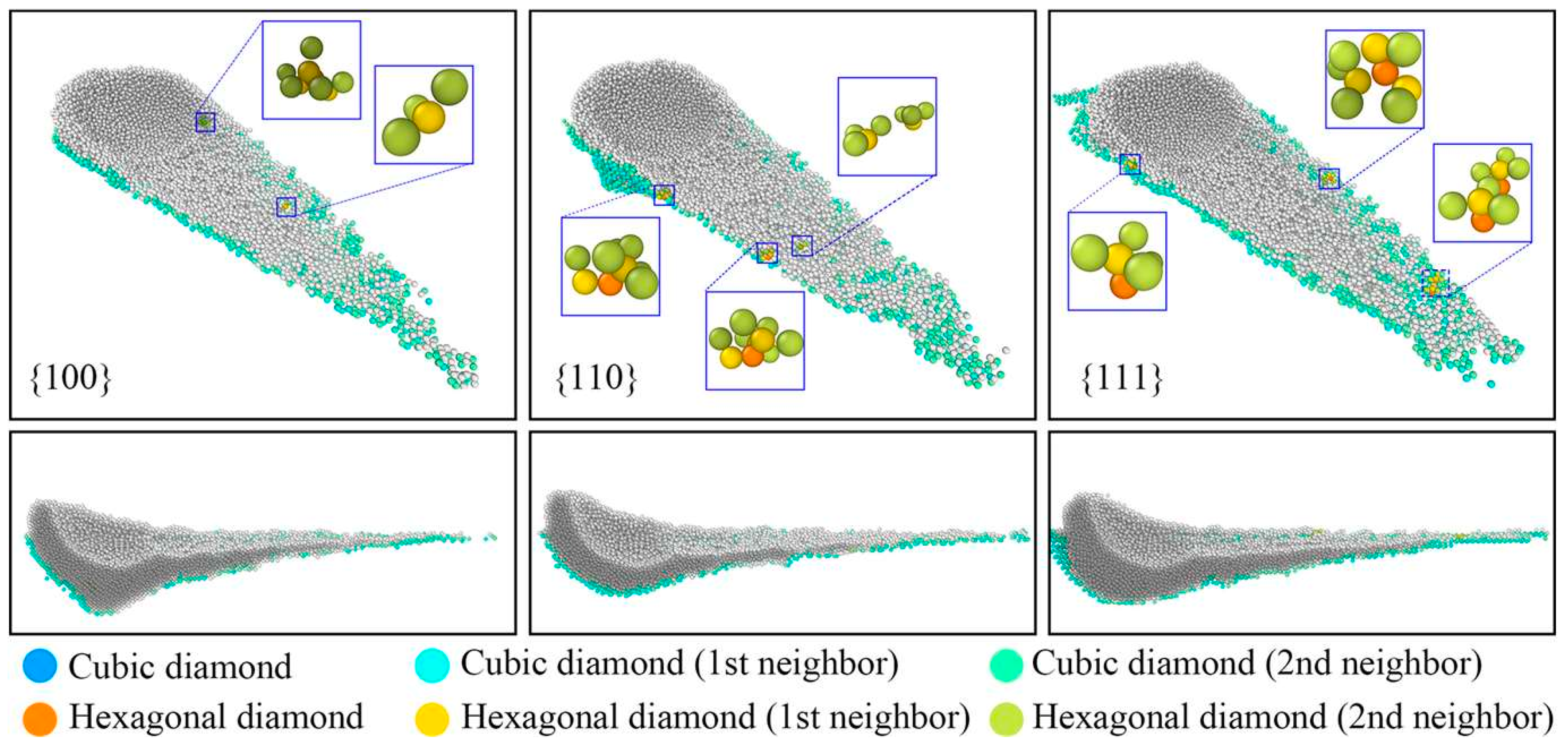
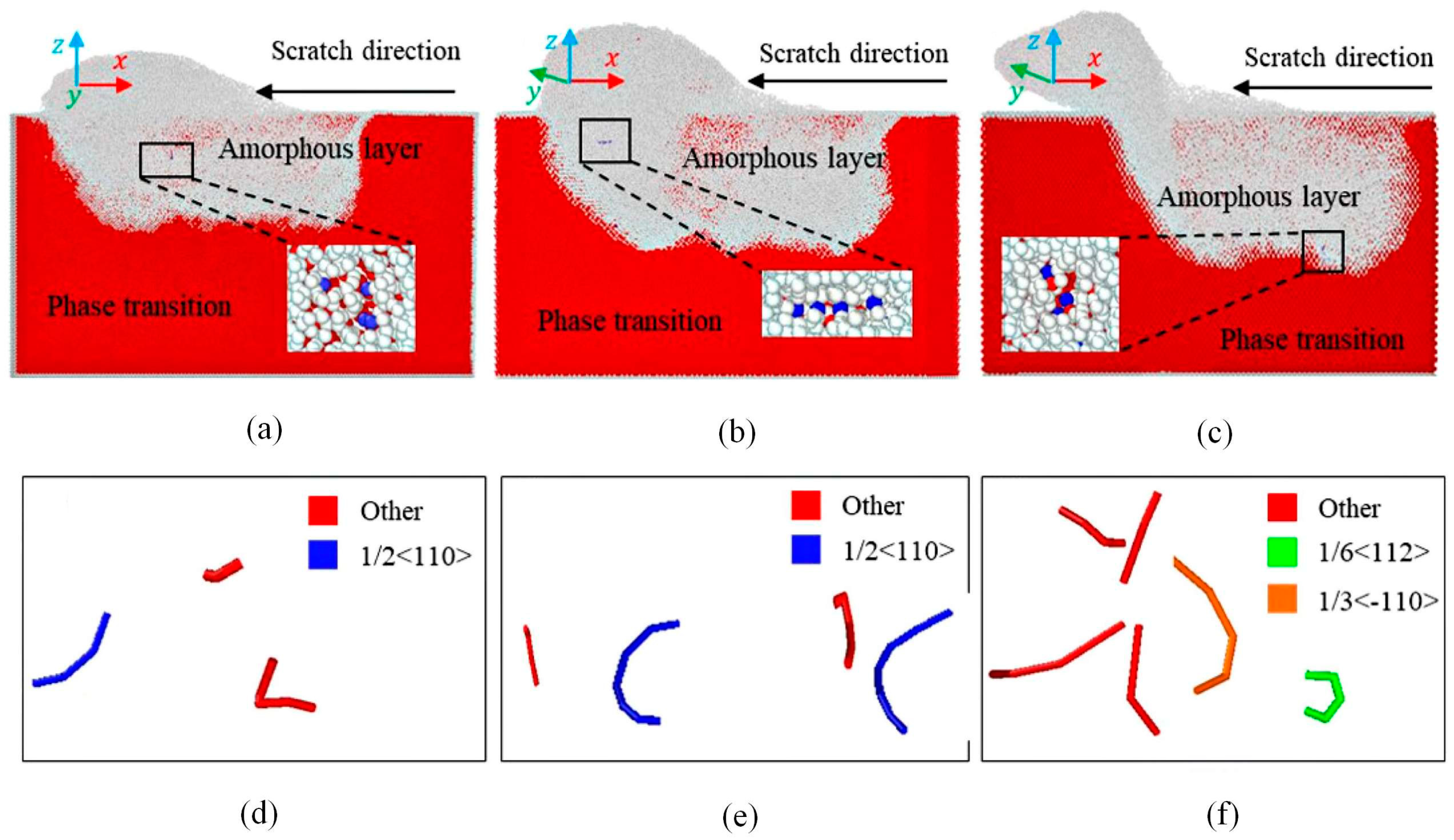

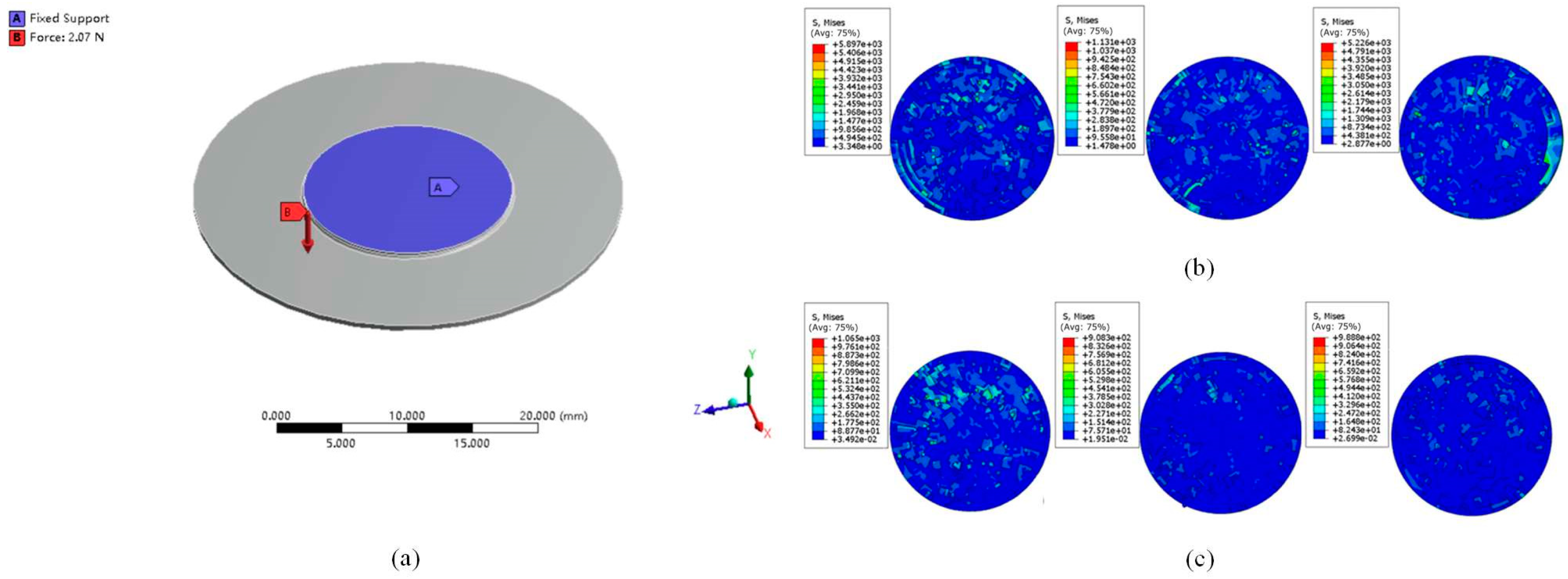

| Authors, Year | Purpose | Findings | Remarks |
|---|---|---|---|
| Li et al. 2017 [27] | To analyze grinding-induced SSD and surface roughness. | This model rapidly assessed SSD non-destructively. | The model measures silicon depth in grinding. |
| Tao et al. 2022 [47] | A novel 3D model revealed material removal and surface generation. | Errors were 5.3% and 12.9% for rough grinding, 7.3% and 15.6% for finish grinding. | The model reveals mechanisms in wafer spin grinding. |
| Gao et al. 2023 [50] | Theoretical analysis of cut depth and removal mechanisms in wire sawing. | Cut depth and roughness increased nonlinearly with the feed-to-wire speed ratio. | This study optimizes precision cutting parameters for silicon wafers. |
| Yin et al. 2019 [51] | A theoretical model determined SSD in monocrystalline silicon. | The model determined SSD depth in 20 s with a <12.0% error. | This research will improve wafer quality. |
| Authors, Year | Purpose | Findings | Remarks |
|---|---|---|---|
| Guo et al. 2016 [95] | Examined the effect of multiple millings on SDL thickness in silicon. | Reduced hardness and elasticity of machined surfaces. | Controlling damage layer thickness improves grinding quality. |
| Li et al. 2021 [96] | Analyzed damage mechanisms in silicon at different grinding speeds. | Analyzed the impact of processing parameters on silicon. | Reveals grinding speed’s effect on silicon SSD. |
| Zhao et al. 2022 [97] | Investigated milling of silicon with different surface orientations. | Observed variations in SSD, forces, phase transitions, and stresses. | Reveals crystal structure and SSD mechanisms by orientation. |
| Liu 2022 [68] | Analyzed DWS mechanisms for monocrystalline silicon. | The study uncovered silicon removal and phase transformation in DWS. | Provides theoretical guidance for optimizing DWS of silicon. |
| Authors, Year | Purpose | Findings | Remarks |
|---|---|---|---|
| Zhang et al. 2018 [120] | Investigated surface damage mechanisms of silicon (100) in diamond grinding. | FEM analyzed grinding zone temperature. | Reveals a new diamond grinding damage mechanism. |
| Wang et al. 2023 [17] | Investigated minimum thickness in silicon wafer machining. | Average simulation error for minimum sawing thickness was 9%. | Improves material use by studying minimum sawing thickness. |
| Zhang et al. 2010 [124] | Evaluated the effects of line speed, feed rate, and grain size on the damage layer. | Lower grain density increased damage layer depth at 10 m/s and 0.194 mm/s. | FEM analysis improves surface quality in silicon cutting. |
| Wang et al. 2021 [126] | Studied ultrasonic vibration effects on sawing temperature. | Validated simulation accuracy with 8.6% average and 14% maximum deviation. | Ultrasonic assistance has minimal temperature effect. |
| Models | Principle | Calculation Method | Presentation of Simulation Results | Remarks |
|---|---|---|---|---|
| MAMs | Mathematical analysis solves complex problems and models situations. | Equations, formulas, functions. | Numerical data, charts, graphs, tables. | The model utilizes math tools to describe the wire sawing process. |
| MD models | Atomic-scale mechanical and thermal behavior. | Open source software packages such as LAMMPS and MPICH. | Dynamic/static figures, predicted data. | The MD model analyzes atomic motion over time. |
| FEM models | The material is discretized and analyzed for deformation and stress. | Commercial software such as ANSYS and ABAQUS. | Numerical data, charts. | It simulates cutting monocrystalline silicon using mathematical models and algorithms. |
| Models | Principle | Verification Method | Advantages | Disadvantages |
|---|---|---|---|---|
| MAMs | Analyze macroscopic cutting behavior, including force and stress concentration. | Direct experimental verification | Quantitative data enhance the accuracy of the cutting analysis model. | Simplification can cause deviations; high calculation costs. |
| MD models | Dynamic material removal predicts machinability. | Validation difficulties | Microscopic observation and prediction of silicon removal and processing properties. | No direct validation; model construction is challenging. |
| FEM models | Study chip formation, predict cutting forces, and analyze residual stresses. | Direct experimental verification | High prediction accuracy and broad usage. | Limited research on material removal mechanisms. |
Disclaimer/Publisher’s Note: The statements, opinions and data contained in all publications are solely those of the individual author(s) and contributor(s) and not of MDPI and/or the editor(s). MDPI and/or the editor(s) disclaim responsibility for any injury to people or property resulting from any ideas, methods, instructions or products referred to in the content. |
© 2024 by the authors. Licensee MDPI, Basel, Switzerland. This article is an open access article distributed under the terms and conditions of the Creative Commons Attribution (CC BY) license (https://creativecommons.org/licenses/by/4.0/).
Share and Cite
Li, A.; Wang, H.; Hu, S.; Zhou, Y.; Du, J.; Ji, L.; Ming, W. A Systematic Review of Modeling and Simulation for Precision Diamond Wire Sawing of Monocrystalline Silicon. Micromachines 2024, 15, 1041. https://doi.org/10.3390/mi15081041
Li A, Wang H, Hu S, Zhou Y, Du J, Ji L, Ming W. A Systematic Review of Modeling and Simulation for Precision Diamond Wire Sawing of Monocrystalline Silicon. Micromachines. 2024; 15(8):1041. https://doi.org/10.3390/mi15081041
Chicago/Turabian StyleLi, Ansheng, Hongyan Wang, Shunchang Hu, Yu Zhou, Jinguang Du, Lianqing Ji, and Wuyi Ming. 2024. "A Systematic Review of Modeling and Simulation for Precision Diamond Wire Sawing of Monocrystalline Silicon" Micromachines 15, no. 8: 1041. https://doi.org/10.3390/mi15081041
APA StyleLi, A., Wang, H., Hu, S., Zhou, Y., Du, J., Ji, L., & Ming, W. (2024). A Systematic Review of Modeling and Simulation for Precision Diamond Wire Sawing of Monocrystalline Silicon. Micromachines, 15(8), 1041. https://doi.org/10.3390/mi15081041






